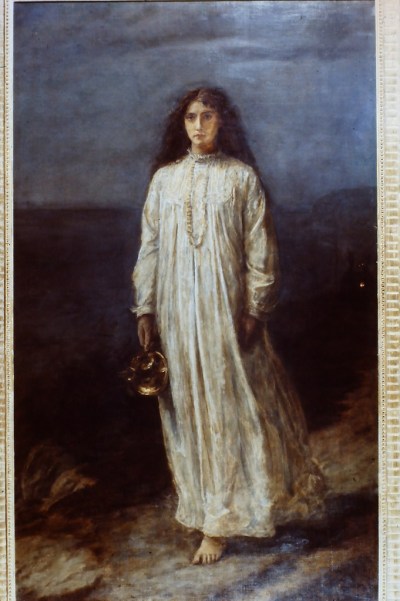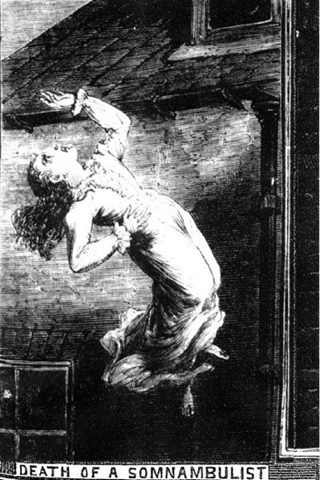
Sleepwalking is when somebody gets up out of bed and starts walking around even though they are still asleep. Some people talk, shout, eat, start moving furniture around, undress, or even get into a car and drive away. Others bolt from the bed and run from some imagined danger, and some people become violent, attacking bed partners or people who try to wake them.
Sleepwalking raises a number of medical, moral and spiritual questions. What causes sleepwalking? Is it an entirely natural disease? Are people responsible for the things they do while fast asleep?
Uncanny Sleepers

There is something otherworldly about a person walking in their sleep. The eyes stare straight ahead with a ‘glassy’ look.
It is difficult to wake the sleeper, and when they do wake up they have no memory of what happened.
You can read about sleepwalking at the American Academy of Sleep Medicine website, sleepeducation.org.
Despite its uncanny nature, sleepwalking has generally been seen as a strange, but entirely natural illness.
The Greek physician Galen (129-200 CE.) records an experience of sleepwalking in his work on muscular motion. He walked about all night and woke up when he tripped over a stone.
Galen drew the conclusion from sleepwalking that the animal spirits within the body remain active during sleep.
Witches and Ghosts
Sleepwalkers have been mistaken for ghosts or people afflicted by demons.
An example of this is the infamous witchcraft treatise Malleus Maleficarum (‘The Hammer of Witches’). This fifteenth-century disquisition warned that a dangerous cult of devil worshippers was active in Europe, who flew at night to attend black sabbath rituals and possessed diabolical powers to cause harm to their neighbours.
The Malleus also claimed that the same demonic powers that enabled witches to fly were the cause of sleepwalking. Sleepwalkers were led by demons to walk over high rooftops in the dead of night.
If the sleepwalker was called by his or her Christian name the power of the demon would be broken and the sleepwalker would suddenly fall down.

The famous English doctor Thoms Willis, who live in the 1600s, believed that sleepwalking was an entirely natural disease. But a sleepwalker could be mistaken for a ghost.
I knew a certain man who was wont after this manner to walk a-Nights like a Spectre.
Thomas Willis
In the 1600s a large house in England was thought to be haunted. Nobody dared sleep in the ‘haunted’ room. One night a guest stayed in the room and discovered that the ‘ghost’ was the family’s daughter, who walked in her sleep.
Marvellous Tales and a Romantic Experiment
There have been many amazing stories told about sleepwalkers.
The Wonders of the Little World, a popular book of marvels published in the seventeenth century by a clergyman called Nathaniel Wanley, included a number of astonishing accounts of sleepwalkers.

There was a man who could write poetry in his sleep. There was a man who, dreaming that he was riding a horse, would get up in the night, put on his spurs and straddle the windowsill with one foot hanging out, smiting the walls.
One story told of a man who climbed down a well in his sleep. Another popular story involved a student who climbed up to the top of the high turret of a castle and robbed a magpie’s nest, all while asleep.
The poet Percy Shelley, an habitual sleepwalker, could supposedly recite poems in Italian while asleep.
To enhance his creative output he encouraged his wife to use the technique of magnetism (a type of hypnotism) in order to prompt him to walk in his sleep.
She had to stop when he tried to jump out of a window!
Troubled Souls
Sleepwalking has featured in a number of famous plays and novels over the centuries, which explore the relationship between distubed sleep and spiritual troubles.
In William Shakespeare’s play Macbeth, Lady Macbeth unconsciously betrays her guilty collusion in the murder of King Duncan and Lady MacDuff while walking and talking in her sleep.

In the Swiss children’s novel Heidi (1881), the orphaned Heidi is sent away from her home on the Alp mountains to live in the city of Frankfurt.
Suffering from homesickness, she becomes troubled and begins walking in her sleep. She is sent back to the mountains to recover.
Her sleepwalking is portrayed in the story as a symptom of the soul trouble that results from exchanging the simple and healthy environment of the mountains for the sophistocated life of the city.
In Thomas Hardy’s novel Tess of the D’Urbervilles, Tess’ estranged husband Angel Clare appears in her room during a sleepwalking episode. While still fast asleep, he lifts her from the bed and carries her across a narrow foot-bridge over a fast flowing river.
She saw the door of her bedroom open, and the figure of her husband crossed the stream of moonlight with a curiously careful tread. He was in his shirt and trousers only, and her first flush of joy died when she perceived that his eyes were fixed in an unnatural stare of vacancy.
Thoms Hardy, Tess of the D’Urbervilles, 1891
Clare’s actions show the power of the unconscious mind and body, which is able to perform amazing feats during sleep. It also shows his love for his wife, unacknowledged during waking hours.
Sleep Murders
Some people become violent during episodes of sleepwalking. In rare cases sleepwalkers have carried out murders. Can sleepwalkers be legally regarded as responsible for their crimes?

In 1312 the Church Canon Si Furiosis (the case of madness) stated that ‘if a madman, a child, or a sleeper mutilates or kills a man, he incurs no penalty for this.’
The first surviving documented case of sleep murder in England was the trial of Colonel Cheyney Culpepper in 1686. An habitual sleepwalker, Culpepper shot an officer of the guard and his horse in his sleep. He was pardoned by King James II.
The sleepwalking defence was first used successfully in America at the trial of Albert Jackson Tirrell in 1846.
In a crime that shocked Boston society, Tirrell brutally murdered his mistress Maria Bickford, cutting her throat so violently that her head was almost severed from her body.
His attorney managed to convince the jury to acquit Tirrell on the grounds that he was an habitual sleepwalker and had no motive to murder Maria.
Embed from Getty ImagesKenneth Parks leaving court, Toronto, May 1988.
The most infamous case of sleep murder in the twentieth century took place in Canada in 1987. Kenneth Parks drove 14 miles in the middle of the night to his parent-in-laws’ home where he bludgeoned his mother-in-law to death with a tyre iron and attempted to strangle his father-in-law.
Parks’ explanation – that he didn’t remember the incident because he was asleep the whole time – seemed highly unlikely. But when EEG readings (which measure electrical activity in the brain), corroborated his story, the jury acquitted him.
Sleep Violence in Film
Embed from Getty ImagesConrad Veidt as ‘Cesare’, The Cabinet of Dr. Caligari, 1921
Sleep violence has been the subject of a number of films. The 1920’s German silent horror film Das Cabinet des Dr. Caligari (The Cabinet of Dr. Caligari) features a sleepwalker named Cesare. Dr. Caligari, an asylum director, is able to control Cesare through hypnotism. He uses him to commit a series of murders while asleep.

In the 2013 psychological thriller, Side Effects, a wife kills her husband during an episode of sleepwalking while under the effects of an anti-depressant drug. She escapes prison by pleading insanity and is confined to a psychiatric unit, while the psychiatrist who prescribed the drug fights to regain his reputation.
The film was directed by Steven Soderbergh, and stared Rooney Mara and Jude Law.
EXPLORE FURTHER
Read
Nathaniel Wanley, The Wonders of the Little World, Or, A General History of Man (1673) is available as a free ebook. The chapter on sleepwalking begins on p. 386 (chapter 23).
Johanna Spyri, Heidi (1881). Heidi was translated into English in 1919 by Elisabeth P. Stork. You can buy it in kindle or paperback version from Amazon. Or read it for free at Project Gutenberg.
Thomas Hardy, Tess of the D’Urbervilles: A Pure Woman Faithfully Presented (1881) is available to buy in kindle or paperback. Or read it for free at Project Gutenberg.
Watch
There have been many versions of Macbeth. You can watch interpretations of the sleepwalking scene with Judi Dench, Kate Fleetwood and Marion Cottilard. A film was released in 2015, directed by Justin Kurzel, and starring Michael Fassbender and Marion Cottilard.
A restored version of The Cabinet of Dr. Caligari was released in 2014. You can watch the trailer at the IMDb web page. You can buy the whole film on DVD (German with optional English subtitles) from Eureka! The DVD also includes a booklet and documentary about the early history of horror film.
The film Side Effects is available on DVD from Amazon.

